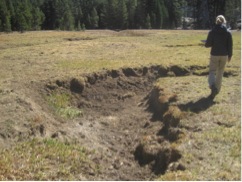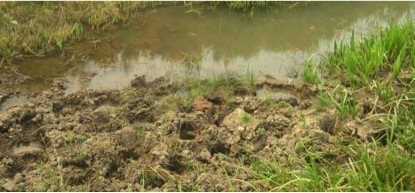Few people understand that livestock grazing on the national forest not only harms wildlife habitat, meadows, riparian areas, and recreation; it also loses huge amounts of taxpayers’ dollars. Grazing fees only bring in a tiny fraction of the money spent by the Forest Service each year to manage cattle.
CSERC serves as a lead conservation group for the Sierra Nevada region when it comes to public forest livestock matters. CSERC staff spent years trying unsuccessfully to build collaborative partnerships with grazing permittees who bring cattle into the forest each summer. There was no interest in any changes.
 For two decades CSERC has monitored livestock damage to national forest meadows and stream areas. Cattle hooves crumble streambanks, pock wetland areas, and pose risk to tiny juvenile amphibians. Overgrazing strips riparian areas of vegetation, turns lush meadows into stubble, and “high-lines” willows so that a diversity of wildlife species lose the willow shrub habitat along moist stream corridors. Year after year, CSERC staff has measured Forest Service-established transects that are supposed to alert grazing permittees to move their cows before utilization of meadow grasses has been exceeded. Every year CSERC staff finds many areas grazed far beyond allowable utilization.
For two decades CSERC has monitored livestock damage to national forest meadows and stream areas. Cattle hooves crumble streambanks, pock wetland areas, and pose risk to tiny juvenile amphibians. Overgrazing strips riparian areas of vegetation, turns lush meadows into stubble, and “high-lines” willows so that a diversity of wildlife species lose the willow shrub habitat along moist stream corridors. Year after year, CSERC staff has measured Forest Service-established transects that are supposed to alert grazing permittees to move their cows before utilization of meadow grasses has been exceeded. Every year CSERC staff finds many areas grazed far beyond allowable utilization.
One of the biggest conflicts between livestock grazing and public interest is the fact that cows contaminate streams with pathogenic bacteria. Lindsey Myers, CSERC biologist, has implemented 4 years of water quality studies consistent with State Water Board protocols. Every year of the studies, the independent certified laboratory that tests the stream samples reveals that many Stanislaus Forest streams are heavily contaminated when cows are present.
Based on CSERC’s two decades of watchdog monitoring, amphibian surveys, water quality surveys, and engagement in grazing debates, our staff recently partnered with four major conservation groups to submit 166 pages of detailed, science-based comments in response to a USFS plan for livestock grazing that affects more than 50,000 acres east of Pinecrest. The USFS proposal would keep the same number of cows and the same length of grazing season despite the fact that half of the vast area’s meadows are unhealthy and many streams are seasonally polluted. The decision for this major grazing plan will show whether the Regional Office of the USFS is truly committed to making needed changes to protect water quality, recreation, and at-risk wildlife from livestock impacts.

This photo shows streambank pocking and sedimentation along the stream at Red Rock Meadow. Cows often congregate close to water — contaminating water quality as well as degrading the riparian habitat that is critical for at-risk amphibian species.

